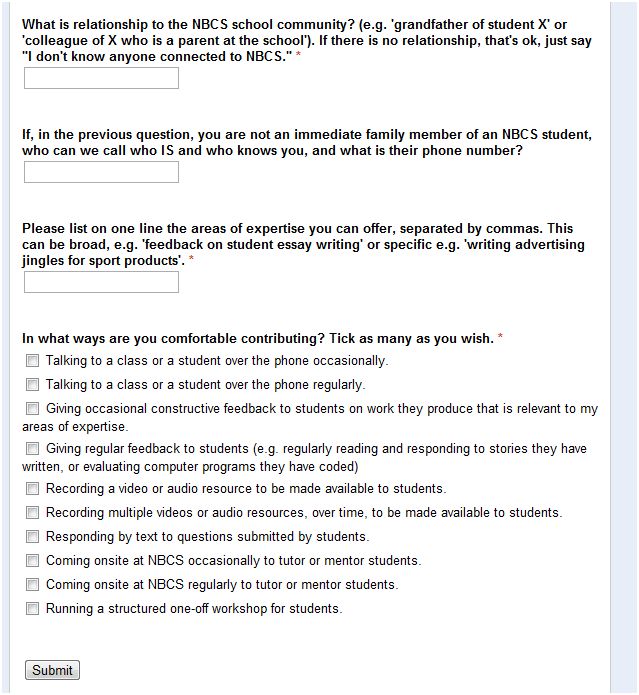If this is the first you've heard of the GAT Course (I haven't revealed what it stands for - can you guess?), it's an experiment at creating a school learning structure that is NOT programmed ahead of time, and is radically student-driven. One student is studying photography, another is writing a book, and another is running a social justice initiative. We hope to grow this structure to encompass all of Year 9 and 10 by 2013.
New South Wales readers might ask me "Is it a Board endorsed course?" I'm not telling. You can guess!
The Granny Cloud
In my second post (this is post #4) I discussed bureaucracy and paperwork. I want the bureaucracy around the G.A.T. Course to be empowering.
I heard the term "Granny Cloud" at the MYSA conference last term. Using the metaphor for cloud computing, the speaker spoke of that 'cloud' of expertise and availability of retirees; of 'grannies'.
I have interpreted the term to include non-retirees; anyone 'out there in society' with expertise and a willingness to share their know-how with students in schools.
Primary schools often do this well already. We have volunteer mums and dads who come on site to give individual support to students to develop their reading skills etc. When I was a tiny thing I still remember a mum correcting me that 'island' is pronounced 'ayland' not 'eezland' in a one on one session. Bless her for volunteering!
In the GAT Course we have students with a variety of interests and projects. After three lessons, students have written up contingent 'project plans', which are very simple, changeable summaries of what they want to create and what skills they might work on along the way, with due dates to help create coherence and momentum.
Meanwhile, I've sent word out to our wider school community: WHO HAS A SKILL THEY'RE WILLING TO SHARE? I've defined different levels of sharing: volunteers can sign up for an occasional phone conversation, or giving occasional feedback on student creations, or offer to create one of our online 'skill badges' (see last post), or run a workshop.
Here is part of the google form they use to volunteer:

Their responses go into a google doc which we, as mentors in the course, can use to match to student projects.
Katrina's Story
For me, Katrina's situation pretty much sums it up. She loves creative writing. She writes lots of stories. She writes lots of novellas. In fact, Katrina has already developed, by herself, the habit of carefully recording and cataloguing her ideas, and even entire passages, in a trove which she can then consult and draw from in future. She might write a passage that just occurs to her, disconnected from any context or broader narrative. She's intuitively realised that a subset of the creativity skill is the habit of treasuring and protecting all ideas without judgement, knowing that they ferment, and recombine, and may prove fertile ground for a new direction at any time.
What good is school, if school gets in the way of the development of Katrina's writing? She doesn't need a teacher. She doesn't need assessment tasks. She doesn't need a sequence of learning activities.
Katrina needs:
- an audience of readers who can feed back to her better information about how they are engaging with her stories.
- a community of fellow-writers, such as those that exist in internet forums, to support each other, egg each other on, applaud each other, and set the bar higher and higher.
- industry-level advice on how to get published.
- to attend local writers workshops.
- to teach other students writing skills and creativity skills.
- well-informed technical review of her best work.
As one of the 'teachers' of the GAT Course, the best thing I can do for Katrina is make these things happen for her.
Can you see where our Granny Cloud fits into this picture?
Last week, Katrina brought in a 100 page document and asked for feedback. I can't be the person to do that. I've got to create structures that allow the GAT project to scale up to 300 students. I have in mind one 'teacher' for 20 to 25 students.
But now I can outsource the feedback to the Granny Cloud. In the Granny Cloud I have every confidence I can provide Katrina with industry-level advice, feedback, a passionate readership, and publishing opportunities.
My first announcement calling for volunteers is only a few days ago. The first responses are trickling in.
Here is a peek at the google doc so far: (no grannies yet, actually, but I love the term Granny Cloud so much that I'll stick with it).

I'm getting shivers down my spine just reading that now!
What will occur in the students' minds as we link them up in a collaborative alliance with industry experts? How will their horizons expand? The whiff of the possible? The sheer REALITY of their learning, with applicability just at their fingertips; tantalising, seductive?
The insanity of the school-bubble can be burst. This isn't an artificial institution, but a launch-pad of careers.
A Learning Village
Time again I think: our society is recovering from industrialisation. Industrialisation was our adolescence, but now we're overturning its artificiality and returning to mythic, tribal modes of relating. Tribal, but not regressive. Mythic, but not mystic; I simply mean a cure for institutionalisation. Wikipedia is a community, not a company, right?
When school is at its best it is a community. At its worst it is an institution.
The more school can be integrated with wider society, the less of an institution it can be. A million ideas are now on my mind but I will say only this: when school has truly become a learning village, an integrated component of local society, where a love of learning is kindled and expertise is shared freely by whoever has it, then we won't need the word 'school' any more.
The granny cloud is a delightful step in that direction!
This is the fourth in a series of blog posts entitled /GAT Project/ They will appear regularly at this website, categorised under 'GAT Project'. If you'd like to receive future posts, you can:
- click here to subscribe to Steve's blog in general by email, or here in a reader.
- click here http://www.happysteve.com/contact/ and indicate 'GAT Posts Only' in the message body - I'll email you when I update the GAT Project just for the duration of the series.
- or regularly check this link for new posts: http://www.happysteve.com/blog/tag/gat-project









